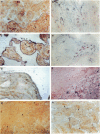Abstract
Terminal complement complex and S protein were searched for in term placentae obtained from 13 women with normal pregnancy and 15 patients with moderate or severe form of pre-eclampsia. Terminal complement complex was found to localize in the fibrinoid material of the decidua of the basal plate, in the stroma of the chorionic villi and in the vessel walls, as subendothelial deposits. S protein had a quite different distribution, being detected in the syncytiotrophoblast located both in the chorionic villi and in the decidua of the basal plate (DBP) and also on the endothelial cells of fetal stem vessels. Mild deposits of C3 were found in the decidua of the basal plate and also in the stroma and on the basal membranes of the villi. Reactivity for C9 neoantigen was also observed in the cytoplasm of some cells, which were recognized to be macrophages by the presence in their cytoplasm of acid phosphatase and by their reaction with a monoclonal antibody specific for macrophages. Differences in complement deposition in normal and pre-eclamptic placentae were essentially quantitative. Possible mechanisms of complement activation are discussed.
Full text
PDF
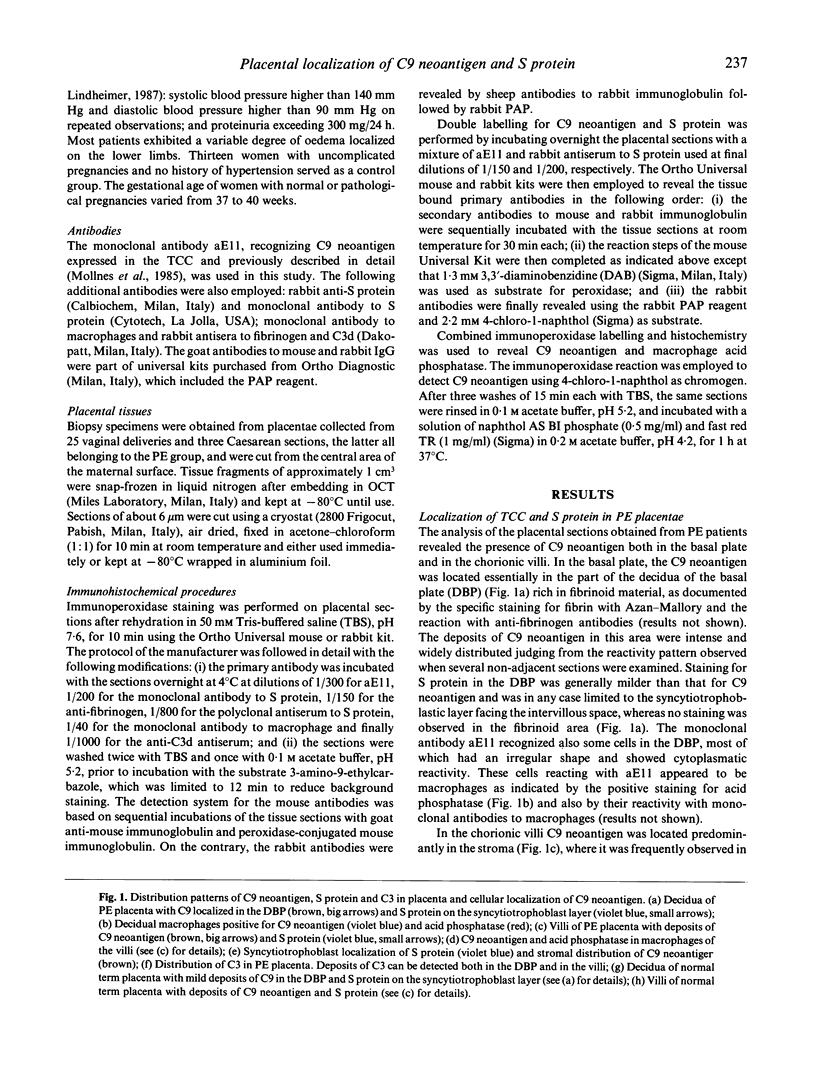
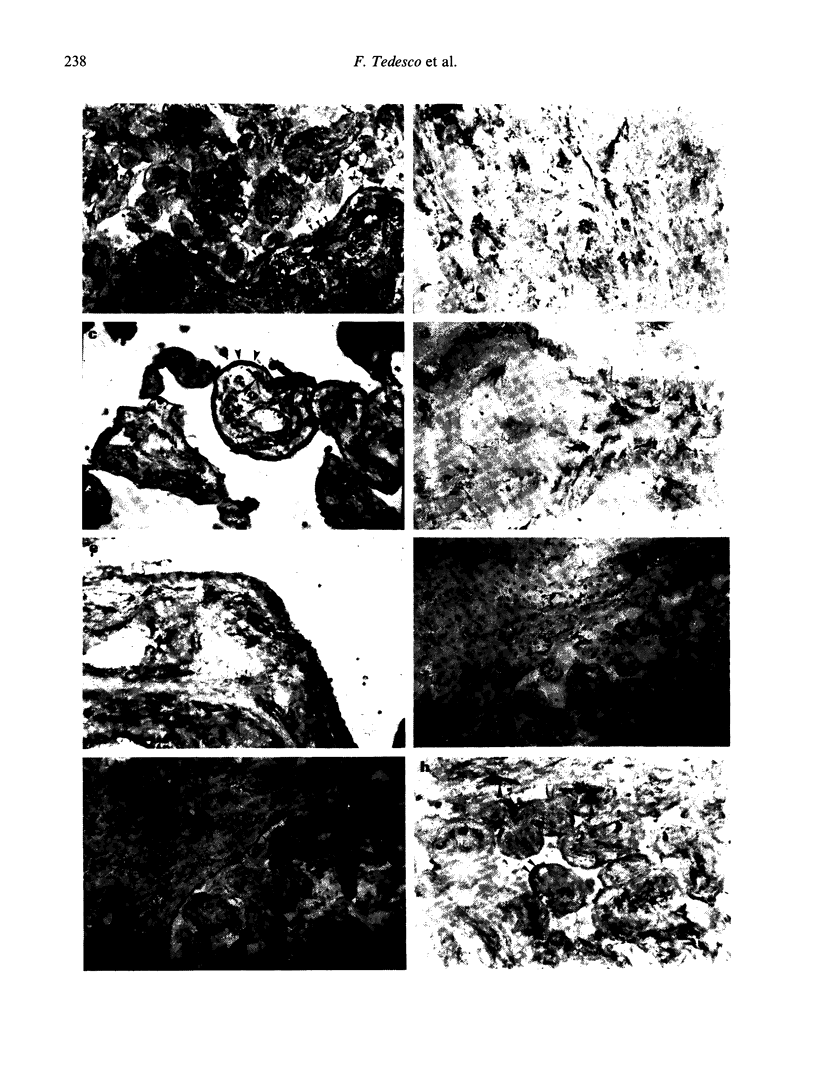
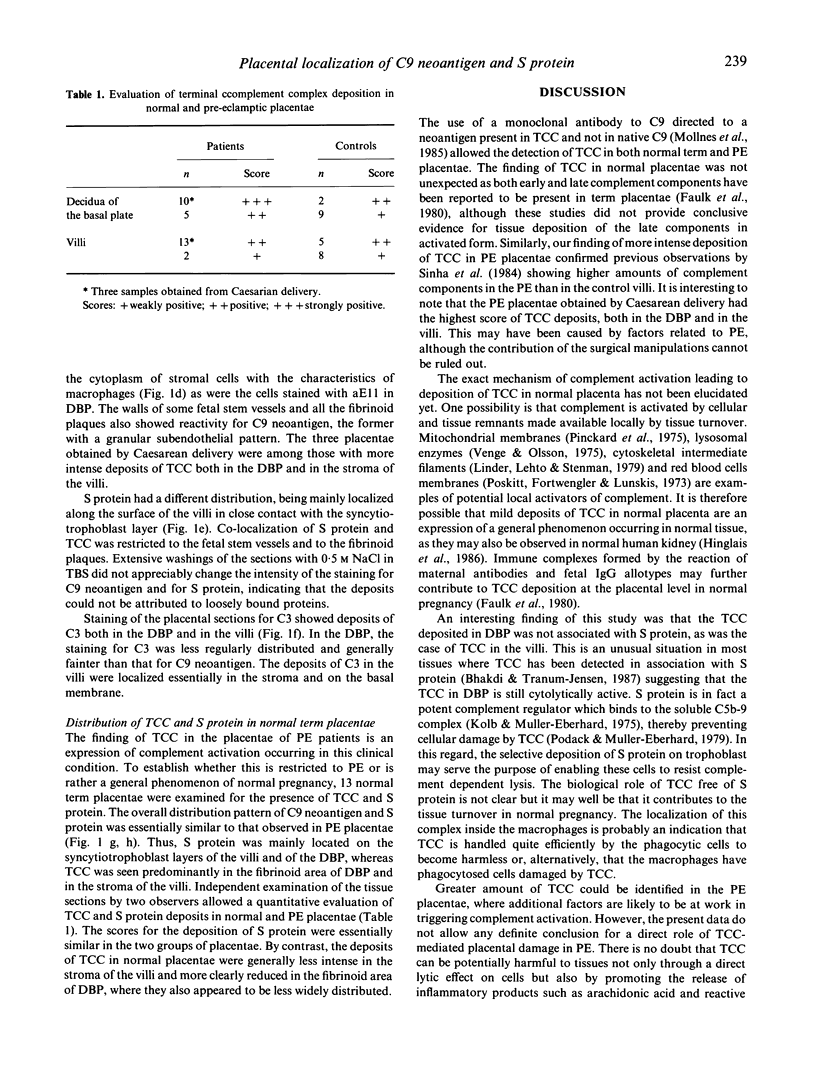
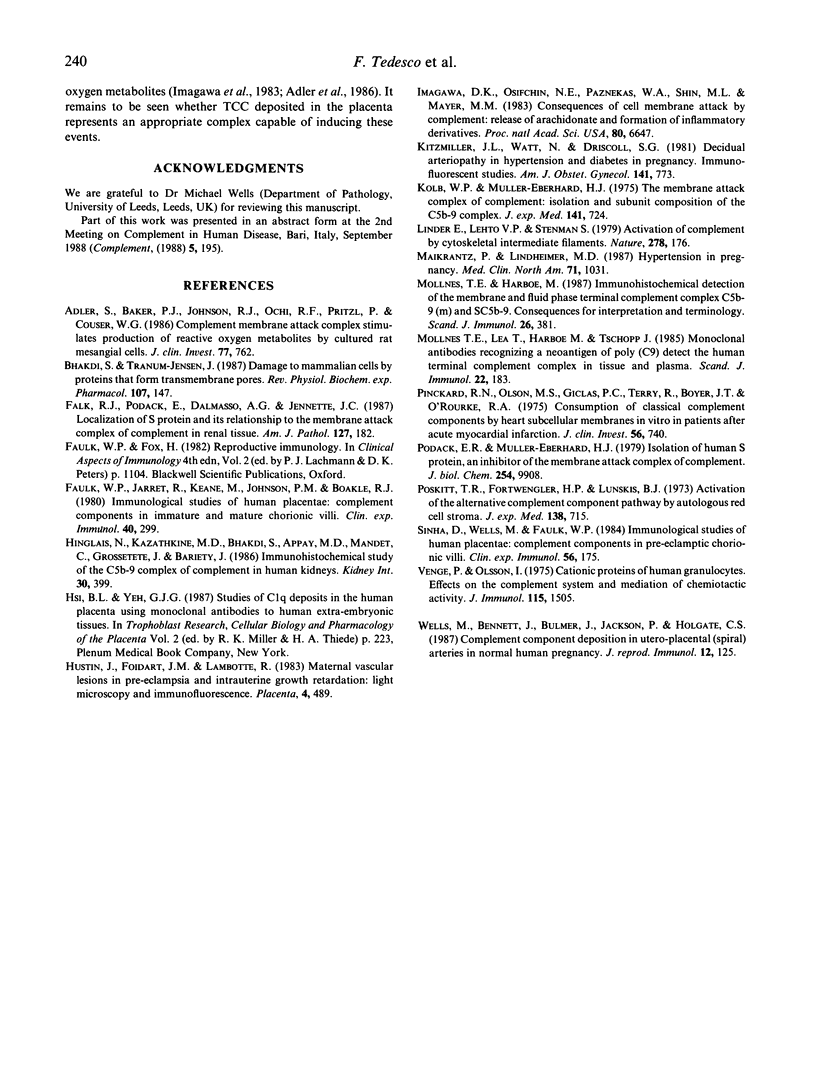
Images in this article
Selected References
These references are in PubMed. This may not be the complete list of references from this article.
- Adler S., Baker P. J., Johnson R. J., Ochi R. F., Pritzl P., Couser W. G. Complement membrane attack complex stimulates production of reactive oxygen metabolites by cultured rat mesangial cells. J Clin Invest. 1986 Mar;77(3):762–767. doi: 10.1172/JCI112372. [DOI] [PMC free article] [PubMed] [Google Scholar]
- Bhakdi S., Tranum-Jensen J. Damage to mammalian cells by proteins that form transmembrane pores. Rev Physiol Biochem Pharmacol. 1987;107:147–223. doi: 10.1007/BFb0027646. [DOI] [PubMed] [Google Scholar]
- Falk R. J., Podack E., Dalmasso A. P., Jennette J. C. Localization of S protein and its relationship to the membrane attack complex of complement in renal tissue. Am J Pathol. 1987 Apr;127(1):182–190. [PMC free article] [PubMed] [Google Scholar]
- Faulk W. P., Jarret R., Keane M., Johnson P. M., Boackle R. J. Immunological studies of human placentae: complement components in immature and mature chorionic villi. Clin Exp Immunol. 1980 May;40(2):299–305. [PMC free article] [PubMed] [Google Scholar]
- Hinglais N., Kazatchkine M. D., Bhakdi S., Appay M. D., Mandet C., Grossetete J., Bariety J. Immunohistochemical study of the C5b-9 complex of complement in human kidneys. Kidney Int. 1986 Sep;30(3):399–410. doi: 10.1038/ki.1986.198. [DOI] [PubMed] [Google Scholar]
- Hustin J., Foidart J. M., Lambotte R. Maternal vascular lesions in pre-eclampsia and intrauterine growth retardation: light microscopy and immunofluorescence. Placenta. 1983;4(Spec No):489–498. [PubMed] [Google Scholar]
- Imagawa D. K., Osifchin N. E., Paznekas W. A., Shin M. L., Mayer M. M. Consequences of cell membrane attack by complement: release of arachidonate and formation of inflammatory derivatives. Proc Natl Acad Sci U S A. 1983 Nov;80(21):6647–6651. doi: 10.1073/pnas.80.21.6647. [DOI] [PMC free article] [PubMed] [Google Scholar]
- Kitzmiller J. L., Watt N., Driscoll S. G. Decidual arteriopathy in hypertension and diabetes in pregnancy: immunofluorescent studies. Am J Obstet Gynecol. 1981 Dec 1;141(7):773–779. doi: 10.1016/0002-9378(81)90703-1. [DOI] [PubMed] [Google Scholar]
- Kolb W. P., Muller-Eberhard H. J. The membrane attack mechanism of complement. Isolation and subunit composition of the C5b-9 complex. J Exp Med. 1975 Apr 1;141(4):724–735. [PMC free article] [PubMed] [Google Scholar]
- Linder E., Lehto V. P., Stenman S. Activation of complement by cytoskeletal intermediate filaments. Nature. 1979 Mar 8;278(5700):176–178. doi: 10.1038/278176a0. [DOI] [PubMed] [Google Scholar]
- Maikranz P., Lindheimer M. D. Hypertension in pregnancy. Med Clin North Am. 1987 Sep;71(5):1031–1043. doi: 10.1016/s0025-7125(16)30825-2. [DOI] [PubMed] [Google Scholar]
- Mollnes T. E., Harboe M. Immunohistochemical detection of the membrane and fluid-phase terminal complement complexes C5b-9(m) and SC5b-9. Consequences for interpretation and terminology. Scand J Immunol. 1987 Oct;26(4):381–386. doi: 10.1111/j.1365-3083.1987.tb02270.x. [DOI] [PubMed] [Google Scholar]
- Mollnes T. E., Lea T., Harboe M., Tschopp J. Monoclonal antibodies recognizing a neoantigen of poly(C9) detect the human terminal complement complex in tissue and plasma. Scand J Immunol. 1985 Aug;22(2):183–195. doi: 10.1111/j.1365-3083.1985.tb01870.x. [DOI] [PubMed] [Google Scholar]
- Pinckard R. N., Olson M. S., Giclas P. C., Terry R., Boyer J. T., O'Rourke R. A. Consumption of classical complement components by heart subcellular membranes in vitro and in patients after acute myocardial infarction. J Clin Invest. 1975 Sep;56(3):740–750. doi: 10.1172/JCI108145. [DOI] [PMC free article] [PubMed] [Google Scholar]
- Poskitt T. R., Fortwengler H. P., Jr, Lunskis B. J. Activation of the alternate complement pathway by autologous red cell stroma. J Exp Med. 1973 Sep 1;138(3):715–722. doi: 10.1084/jem.138.3.715. [DOI] [PMC free article] [PubMed] [Google Scholar]
- Sinha D., Wells M., Faulk W. P. Immunological studies of human placentae: complement components in pre-eclamptic chorionic villi. Clin Exp Immunol. 1984 Apr;56(1):175–184. [PMC free article] [PubMed] [Google Scholar]
- Venge P., Olsson I. Cationic proteins of human granulocytes. VI. Effects on the complement system and mediation of chemotactic activity. J Immunol. 1975 Dec;115(6):1505–1508. [PubMed] [Google Scholar]
- Wells M., Bennett J., Bulmer J. N., Jackson P., Holgate C. S. Complement component deposition in uteroplacental (spiral) arteries in normal human pregnancy. J Reprod Immunol. 1987 Oct;12(2):125–135. doi: 10.1016/0165-0378(87)90040-4. [DOI] [PubMed] [Google Scholar]



